 |
Gardening |
 |
of the products and services displayed in the banner ads. |
 |
Gardening |
 |
 We started in 1976 when we built the house. I bought the land with the money paid to us, after all those years, for our land in Nebraska. It was a paltry $1,500.00 but my mother said, "Bury it in the land. That is blood-money paid out to us for our lands, the lands of our ancestors in the North." This was a burned-out wheat-field that would not grow weeds, I kid you not. There were no worms, period. The ground had been so heavily fertilized for the wheat, until it just gave out, I guess. This is a ridge, and that made it worse, I suppose, with everything washing on the side of the hill. Immediately, I scattered out Fescue Grass seeds. 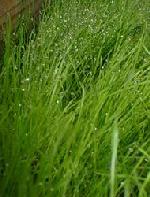 The wheat farmer had plowed and tilled the ground, so it was ready for seeds. The Fescue came up immediately, it seemed, and was there to hold the ground intact before the spring rains. I could not afford to have it landscaped, so my husband, Rodney, and I drew out the plans ourselves, and, with the help of my art skills, were able to create a reasonably well laid out plan. Since we did not have the $2,000.00 needed to carry out the plan, we simply began adding $200.00-worth a year to the place, until, over an almost 25-year period, we finally achieved what we now have. The trees I was able to purchase for $18.00 a year, for over a two-year period, from the State. My dad fussed something fierce because I chose Locust Trees along with Pine Trees. 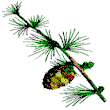 The Locust help in building up the soil, but they are terribly invasive. The neighbors now have a hardy crop of the things! They are a thorn tree, so every year, I would take a broom stick and knock the thorns off, for as far as I could reach up, and I kept them pruned from any lower branches. My original plan was to plant a couple of Pecan Trees a year where the Locust Trees would die out, as they often do, from a borer that kills them. So far, I have fallen down on this part of the plan. Maybe this year I will use the $200.00 budget for Pecan Trees. For this amount, though, they will be small, which seems to be a curse upon them here. One year the sheep ate them up, another year, the gardener kept them mowed off and eventually killed them. The only way you can buy from the State is to purchase quite a number of trees of their choice, like five-hundred or a thousand. There was no way I could plant a thousand trees on an acre, so now the neighborhood is host to Pine Trees. One person moving into the area said, "Wow! Never thought I'd be living on the Ponderosa!" Some I took to family who live close to White Eagle (the Ponca reservation), and it is a joy to drive by there now with the Pine Trees reaching up so tall. The cousin who planted them is gone now, but his trees live on. One year I planted Privet Hedge. It was forever before it finally took hold, because it was on the poorest part of the hill. All at once, it grew and was a beautiful hedge. I trimmed it for years, but then my back began to act up, due to those spinal anestheias I'd been given during the birth of my children. The vibration, from the electric hedge trimmer necessary for that size of a hedge, seemed to literally pull my back out of place. There was nothing else to do but have Rodney hook onto it with a tractor, and pull it out. I replaced it with a Rose Variety that is supposed to do well in poor soil. So far, it is living and produces wonderfully big Rose Hips, 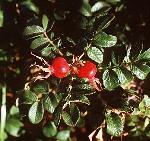 which the Bluebirds do love, and so far, that is turning out. This Rose Hedge is supposed to get to be over six feet tall, and can also be as wide. At this point, after four years, it is barely knee high, but looks better every year, so maybe someday.... There is the thought of gathering them for Rose Hip Tea, which is very high in Vitamin-C. On the West of the yard, I wanted a "natural" fence of Pyracanthia. 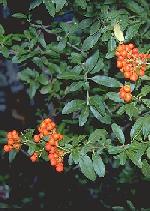 So far, I have six bushes there. This year, at least four more. When these bushes are established, we can pull out the ugly chain-link fence that is necessary to protect them now, while they are small. Riding lawn mowers are wonderful work-easing tools, but they also make it easy to mow down everything equally - grass, small trees, bushes, etc. One year I put out a Quince Bush because I love Quince jelly. 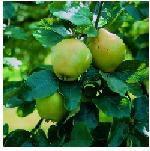 For four years, it only survived because it kept getting mowed down. Finally, I set it out farther from the house, and placed a circle of cement blocks around it. This spring it was a thrill to look out one morning, through the large glass door off my daughters bedroom, to see the bright, orangey-red blooms on the healthy-looking larger bush greeting us at the earliest of Spring. To the right of it, set the Forsythia 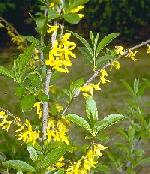 (yellow Easter Bush) my mother gave me one year, and, of course, the two bushes bloom at the same time, complimenting each other with their bright welcoming for Spring. Starting with six or seven Jonquils, filched from my mother's yard, 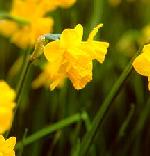 we now have a mass of bright yellow along the fence which was put in from the posts cut from Locust Trees. By the way, it isn't true that they won't bloom if you divide them. In fact, they seem to do better if you do separate and divide them. I wait until they finish blooming, leaving a couple of healthy-looking clumps undisturbed, to insure a nice group of showy blooms for the next year. I learned this from a neighbor who lived behind my grandmother's home in town, one Mrs. Stubblefield. By the time she passed away at some 90 years of age, she had an area, which in the Spring, was a mass of bright Jonquil blooms. One year a friend handed me a clump of Violets.  Now in front of the house, located on the North where it is cool, there is a solid bed of them coming up this Spring. Our yard budget-money for this year, is partially used up via the Rock we put in  for a drive to the trailer out back. The tractor to spread it had to be rented. The rock is pretty good size, some bigger than pea gravel. It made a great drive up to our back door, located on the South, making it easier to routinely load and unload the wheel chair used by my disabled daughter. The gravel will help to hold moisture, too. I plan to set in a row of Poplar Trees along the edge of the drive, which should result in several goals, ie., (2) Slow water/moisture from washing away. (3) Offer privacy. (4) Act as a wind break. There is the ever-necessity of slowing down what can be a most annoying factor - the Oklahoma winds! (5) At that point upon when their life is spent, act as fence posts, or be used in whatever ways in which wood can be used. (6) For the present, the charm of tall, narrow Poplar Trees, offers a beauty akin to the hills of Greece, reaching up high and visible for quite a distance. He encouraged me to set in beds which would stop the mowers. This he did, with pick and cement blocks. They are a plus, since I can have flowers, without having to water a large area. This year, I plan to pick up the cement blocks and replace them with landscape timbers. A neighbor grows Canna Lilies for selling, at a terrific price of 12 for Three Dollars ($3.00)! We discovered that putting them over the septic system laterals, we could have gorgeous, tall, showy plants. 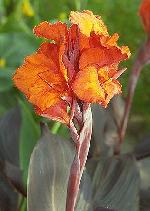 The Hummingbirds love the little red blooms, and that is nice also. 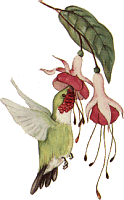 Three years ago, Rodney built, at the expense of our infamous "Two Hundred Dollars," a beautiful heavy arbor. The boards across the top are pressure-treated 2x6's. The posts holding them up are the steel beams from an old trailer house. Onto that, he trailed the Wild Grape Vine that was already there. Last year, it rapidly covered the top, creating a wonderful shade over the cement patio. On the sides of the arbor, he put the lattice-work pieces, and painted them a Hunter Green. It is amazing how this breaks the wind that comes onto the house, via the North. It even helped on our heating bill this Winter. The children love the protected area in the Summer, and also on the cooler days of the Winter, since the wind being broken, offers a warmer area. Therefore, this year, Rodney is going to do the same to the South side of the house. This will provide needed shade off my rather warm kitchen area, during the hot Summer. It will give the children a much nicer area this Winter, on the sunny and warm South side of the house, plus a cooler area this Summer. My love of gardening was hampered for years by the high cost of rural water. My husband was determined to have a well, despite the stories there was no water here. I knew there was water because my son had "witched," and I saw the peach tree limb turn down where it was. The men came out and also witched a place where they said two veins ran together. The day they drilled, Rod was working and couldn't be here. I will never forget the look on the men's faces when they were not hitting water. They kept coming to the door asking me what to do, I kept telling them to keep drilling. Finally, at 120 feet, they only hit a dribble of sandy-looking water. Then, they wanted to know whether to fill it back in with cement, or put down casing. I told them that even if it was only a dribble, I wanted it, and to go ahead and case it. They did. Something about putting that casing in, tapped into the vein, and when they left, the water came in like an artesian well! Rod let it shoot clear up a hundred feet in the air for a couple of days! I told him he was "showing off" for the neighbors who said there was no water. It came in producing 60 gallons a minute. I guess that is right, is the way it is measured. Anyway, it was a lot! Rodney had to work extra hard that year in order to pay the bank off for the loan, but it has been a wonderful thing. The extra water to water the garden and the flower beds, has been wonderful, making it possible to have a lovelier yard. One of our neighbors has a pond, and they pump up water from it for the yard, but on this acre, of course, that isn't possible. There is the story of the Junipers. They are subject to the little Bagworms, not Webworms, but the the little parasite that stay encased in a little bag hanging from the branches. 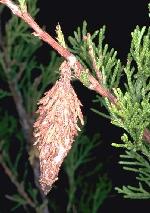 After years of observing the little monsters, I discovered that if you are careful to remove the bags, they are not able to reproduce since the eggs are in those little cases. One has to be careful not to touch the critters, since they carry some germ that can cause a skin irritation. I take small shears and cut them off, drop them into a paper sack which I soak in kerosene and burn. One has to be ever vigilant, since they have a way of sneakily hiding in behind and under branches. In order to squelch this little habit, I keep the bushes pruned until they look like overgrown Bonsai Trees. In this way, I am able to see the bags before they are able to hatch out. With the branches pruned out, it allows the wind and sun to get through the bushes, which seems to make them healthier and stronger. This also helps to keep the attack of the parasites away. On the East are the tall, Wild Cedars which my son helped me put there when he was in the Eighth Grade, and there is a story behind this. That year was a particularly hard year for my son. His leg had been broken in a Thanksgiving Day dog-pile football game. In order for him to stay in school, I had to put him in a country school some distance from here. We drove every day through Winter ice. Rod's dad bought me a set of ice tires, which gave me the traction I needed in driving my son to the school. There were plus and minuses about the school. He had a wonderful teacher who was so brilliant and creative. However, there were things that went on in the school which, no doubt, caused the principal to be let go. I didn't know exactly what, but one parent was adamant in his outrage at what had transpired with his son. I'm sure that my son was touched by the thing, too. On the last day of school, I was so hurt by the thing, that the only way I could cope with it, was to release stress by placing a shovel in the back of the car and going scouting for wild plants, taking my son with me. He and I dug up Cedars growing wild along the roadway off an old, deserted ranch site located close to the school. We brought the Cedars home and planted them as a wind-break. Today they reach up probably forty feet and are a wonderful wind-break. They are especially resistant to those little parasite Bagworms also, which makes it nice. It was my way of making something beautiful out of what was ugly. The thing I want to accomplish this year, is to set a trough out front on that very poor soil. I plan to build it of landscape timbers. I want to fill this with peat moss   and and some   large largeEarthworms.   Hopefully, they will help loosen the soil and increase its production. There are already some there, from when my German-descendant neighbor put worms out in his yard. Evidently, the rains washed the worms down to the area under our Pine Trees. Night Crawlers is the name of that particular Earthworm, and they are sought-after by fishermen. On Vegetable Gardening, I am always amazed at the toughness of the Broccoli plant. This year, we put some out in the middle of February, and although we had some very cold weather, the Broccoli just seemed to "hunker down" and get greener leaves. The Red Cabbage is doing well, as is the Regular Cabbage. The Green Onions are doing well here at the First of March, and my Lettuce is up. We are going to have a snow this week-end, the weather man says, and hopefully, the ground will be warm enough to keep the things from getting nipped. We love the Broccoli, and the leaves can be eaten as well. When I plant my Squash, I always plant Radishes around the Squash plant. This helps to keep off the bugs. Also, after the plants some up, I spray the stalks daily with a solution made up of about a tablespoon of cayenne pepper mixed into a quart-size spray-bottle of water. This spray mixture keeps the Squash Bugs off, and hardens up the stems. Those little bugs that can suck the stems dry over night, get a big taste of cayenne! This year, I have Tomatoes coming up, about three inches tall, in the house, in an old cake pan. These are the Heritage variety, and hopefully, I will have seeds to save. The t.v. showed me to put the seeds in a jar of water, let it sit for about three days, then pour off the water, leaving the seeds clean and ready to be dried and saved. I'm looking forward to the new experience of saving Heritage seeds. I already save Marigold and Zinnia seeds, which is a great plus. It is nice to have brown paper sacks of seeds, in mass, instead of the expensive little packages of seeds you get from the store. With saving seeds you just must be careful not to save the hybrid varieties. They will not produce well from the seed. Speaking of seeds, probably the nicest gardening is in the dead of Winter, via the growing of Mung Beans, Lentils or Alfalfa seeds in a jar for sprouts, to liven up your salads. The vitamins are a plus, too. I keep the jars sitting over the sink, and just swish water over them two or three times a day, rinsing them off. There are lids with holes in them you can buy in the health food stores. Or you can use an old nylon sock over the top, held on with a rubber band. With vegetable gardening, there is no other method as wonderful as the use of mulch. What a lot of nuisance it cuts down in not have to hoe, hoe, hoe. Herb Gardening is a great experience too, and a matter of overlapping ones flower gardening with the herbs. BASIL has to planted every year. There is nothing greater than fresh basil leaves with thick slices of peeled tomatoes in Italian oil and vinegar dressing. THYME will most usually winter over, except in a very cold Winter. MARIGOLDS are an herb also. I save the leaves, dried for salads. The yellow petals I cut off from the black seeds. I save petals and add to anyplace I need color. This is supposed to be a protection from cancer. ROSEMARY is great, but here it must be brought in or replanted every year. SAGE I do not use for cooking, but I put it in vinegar for our hair. Also, I use it in my mop water, it is inexpensive. SORREL is a great plant and wonderful sharp sourer in salads. It is intrusive and some people don't like this about it, but we usually use it before it has a chance to intrude on anything. Ha! 
|
 GUESTBOOK of Donna's Doorways Website | ||
 Links To return to the page you came here from, use your browser's "BACK" button, or clickon below for: | |
 |
 |